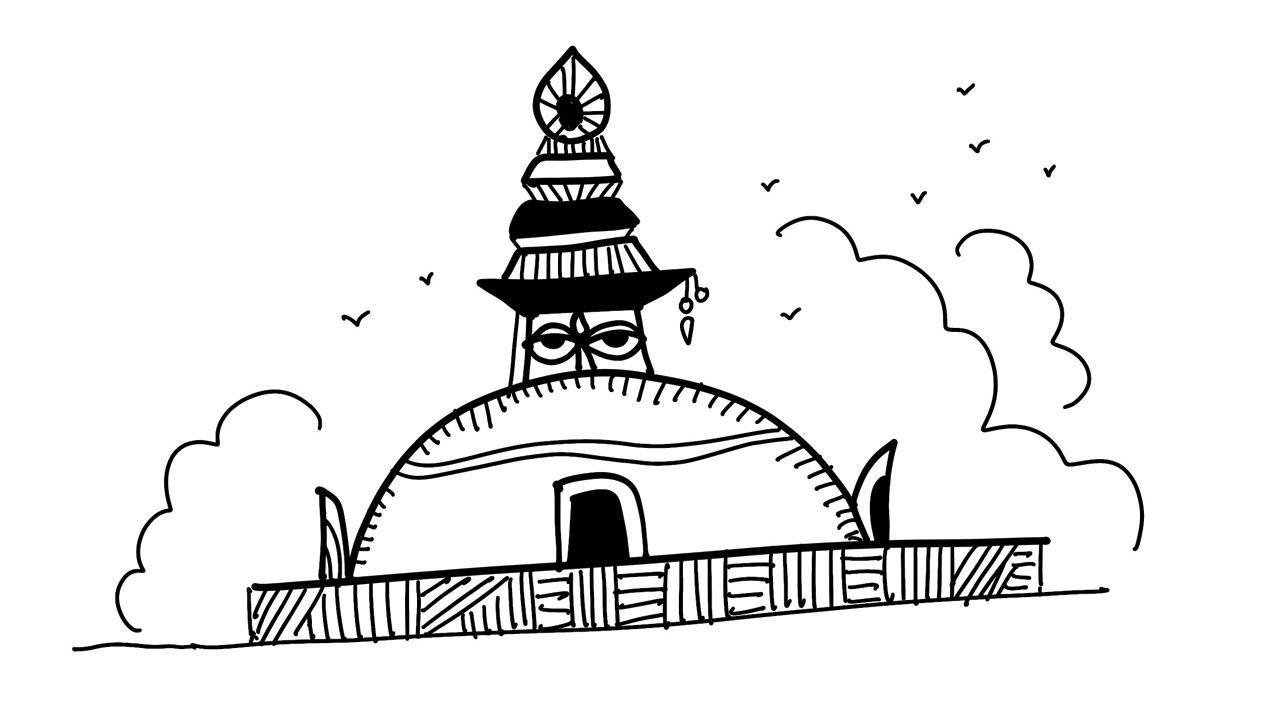According to legend, when the Buddha died, the kings of India fought over his bones, which were eventually divided into eight parts

Illustration/Devdutt Pattanaik
 The Buddhist stupa originated as a very simple idea. After the Buddha was cremated, his bones were collected and placed in caskets, which were then covered with a mound. A parasol was placed over the mound to indicate his great status, and people would go around this mound, in clockwise direction, to express their veneration of the teacher.
The Buddhist stupa originated as a very simple idea. After the Buddha was cremated, his bones were collected and placed in caskets, which were then covered with a mound. A parasol was placed over the mound to indicate his great status, and people would go around this mound, in clockwise direction, to express their veneration of the teacher.
ADVERTISEMENT
Over time, stupas became larger and more elaborate. They were covered with stone, and railings were added around them, like those found in the Sanchi Stupa. These railings had four doorways indicating the four directions, which started becoming more important. The doorways were identified with the kings of the four directions. The railings were decorated with images of the Buddha’s life, his past lives (Jataka tales), and the patrons who funded these grand architectural structures.
According to legend, when the Buddha died, the kings of India fought over his bones, which were eventually divided into eight parts. Later, during Ashoka’s time, these relics were collected and distributed to 84,000 locations. This idea of a king establishing stupas across his empire and attaining great fame is also found in Chinese scriptures. A Chinese emperor is said to have spread stupas across China, similar to what Ashoka did in India. Thus, stupas started having lives of their own.
Later, stupas began being enclosed in halls known as chaityas, which were surrounded by monasteries or viharas. These can be found in the caves of western India, where stupas are located in the middle of halls. These stupas may or may not contain the Buddha’s bones, but they did contain pots with sacred objects associated with the Buddha, which was the most important element. The stupas themselves started being decorated with beautiful ornamentation, symbols, and images.
Images of the Buddha started appearing on stupas after 200 AD, sometimes sitting, standing, or meditating. Some stupas depicted the Buddha in different postures on four sides, sometimes touching the ground, sometimes meditating, or showing particular gestures to indicate wisdom.
In Southeast Asia, stupas became taller and started being referred to as pagodas. Stupas were not limited to the Buddha but also included great teachers and kings. It was imagined that the stupas were rising to the heaven of the thirty-three gods above, and then going beyond to Buddha realms.
In many parts of Tibet and Nepal, stupas were built to reflect Buddhist cosmogony. The lower part of the stupa represented the earth, gradually narrowing and widening again to show the shift from the realm of mortals to the realm of immortals. It then narrowed back again to show the realm of the Buddha. High above was Adi Buddha, the primal Buddha, who embodied the Dhamma itself, an idea that became popular from the 10th century onwards, especially in East Asia.
Thus, we see the stupa transforming dramatically over time. Today, in many parts of the world, going around the stupa is a very important ritual in Buddhism. It is seen as walking meditation, while images of the Buddha seated, standing, or lying down are placed in halls where sitting meditation is practised. Stupas remain popular, however in more and more places, people are preferring giant images of the Buddha and even Bodhisattvas. Unlike stupas, which indicated mortality of a historical figure, the giant images embody something eternal and transcendent--the infinite and eternal Buddhas of the Mahayana school.
The author writes and lectures on the relevance of mythology in modern times. Reach him at devdutt.pattanaik@mid-day.com
 Subscribe today by clicking the link and stay updated with the latest news!" Click here!
Subscribe today by clicking the link and stay updated with the latest news!" Click here!







